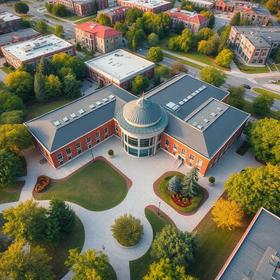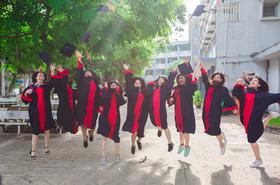Some see it as the “easy way out.” Minimal entrance requirements, open enrollment, and a wide variety of basic and remedial courses give some people the impression that the community college experience is not academically rigorous. Although there might have been some truth to this stigma a few decades ago, community colleges of today are on the leading edge of education, particularly for new and emerging career areas experiencing explosive growth. Yet, many myths about community colleges still exist.
Myth #1: Students Rejected from Four-Year Colleges
Perhaps the most pervasive stereotype about community college students is that they are there out of academic necessity, not out of choice. Some people assume that four-year institutions' more stringent entrance criteria are too much for ‘those students’ to meet, forcing them to study instead at a local junior college. While academic necessity is a reason for some students to attend a two-year institution, the overarching reason why students choose to attend a community college is cost-effectiveness.
The per-year cost of a university education is roughly three times that of the per-year cost of attending a two-year school. With many 21st-century careers needing only an associate’s degree and increasingly smooth transfer procedures from community colleges to universities, completing the first two years of one’s education at a two-year institution makes a lot of financial sense. The flexible nature of community college scheduling and the availability of scholarships and grants means that many students can obtain their associate’s degree or equivalent professional certificate with little or no college loan debt. Thus, for most, attending a two-year institution is an intelligent financial choice rather than a last resort due to poor high school grades or low standardized test scores.
This video debunks the myth that students only attend community college because they cannot get into a 4-year college.
Myth #2: All Community College Students are Older
The average age of a community college student is 29, and compared to the average age of a university student, which is currently 21, it’s clear that many community college students are indeed older. However, community college students are getting younger and younger with every passing year. According to The Atlantic, in 1995, the percentage of community college students between the ages of 18 and 24 stood at 47 percent. As of 2009, that number was 54 percent. That number is assuredly higher today. The number of under-18 students at community colleges has also greatly increased as dual enrollment courses become increasingly popular for high school students. In 1993, just 1.7 percent of community college students were under 18, but by 2009, that number grew to seven percent.
Myth #3: Community College Professors are Second Rate
Community college professors' educational background differs from that of their university counterparts. Two-thirds of professors at two-year institutions have a master’s degree and one-fifth have a doctorate, compared to 80 percent of university professors with a Ph.D. While the number of professors with a Ph.D. or other terminal degree is lower at community colleges than at four-year institutions, teaching is the primary focus at two-year institutions. Professors with real-world experience teach classes. Conversely, professors at the university level often have responsibilities other than teaching, mainly research and publication. As a result, some classes at four-year schools are taught by teaching assistants or graduate students, not by the professor of record.
Professors at the community college level are also much more likely to work with students on an individual basis. Smaller class sizes mean that students and teachers have more opportunities for interaction. Professors are more likely to know individual students, their needs, and their academic abilities than is a university professor teaching a freshman-level course with hundreds of students in each section. In many cases, this individualized attention is what makes the difference between success and failure for a student, not the level of education of the professor.
Myth #4: Community Colleges Don’t Offer Many Majors
Decades ago, this myth was true. Aside from a few liberal arts degrees and a smattering of vocational certificates, community colleges didn’t have much to offer. Today, however, is an entirely different story. Community colleges fill a void in workforce preparation that changes quickly as the economic landscape shifts. High-demand jobs in technology, medicine, green industries, and energy exploration are great in number, and community colleges nationwide have done well to devise degree and certificate programs to prepare students to fill voids in these career areas.
Additionally, community colleges have increased the number of academic majors to meet the needs of students who seek to transfer to a four-year institution. According to data from the National Student Clearinghouse Research Center, 60 percent of students who transfer to a university obtain their bachelor’s degree. This would not be possible if community colleges didn’t offer an expanded array of majors.
Dispelling the Myths
One reason that community college myths persist is a lack of accurate information, particularly on university campuses. A recent report by Louisiana State University revealed that community college transfer students at that school experience “a sense of inferiority that pollutes their college experience.” According to school officials, negative perceptions exist because just six percent of LSU’s students come to campus from a two-year institution. The institution’s president, F. King Alexander, says that boosting that number will reduce the stigma transfer students encounter.
Alexander knows what he's talking about, coming from California State University, Long Beach, where 50 percent of students transferred in from a community college. Students that transferred there, he said, “were not stereotyped” because of the sheer number of them on campus. Another factor that has helped erase the stigma of being a community college student is that California has made the transfer process as smooth as possible. The state’s Assist system provides detailed information regarding how credits will transfer from California’s community college system to the University of California and California State University systems. Students can log in to the system to explore how their credits will transfer based on their school, the school they plan to transfer to, or the major they have chosen.
Furthermore, several University of California system members offer guaranteed admission for California community college students. In some cases, these students have priority over students from four-year institutions, both in-state and out-of-state.

The California State University system also offers priority transfer agreements to the state’s community college students. Because of these programs and campus-specific services for transfer students, California’s universities have many community college transfer students. These programs also go a long way in dispelling negative stereotypes about students who choose to attend a community college.
Now that he’s at LSU, Alexander has overseen the development of a transfer program called LSU Bridge, which, much like the programs he left behind in California, seeks to ease the transition for students coming to LSU from community colleges. The program allows students attending Baton Rouge Community College to access services at LSU and even live on LSU’s campus during their freshman year. Provided they meet certain performance criteria, students are automatically admitted to LSU after completing their second semester. Students who complete Bridge are also invited to serve as mentors to incoming freshmen, providing needed support and guidance as well as providing a social connection to peers who are full-blown university students.
This video explains the relationship between Louisiana State University and Baton Rouge Community College.
LSU hopes the Bridge program will eventually boost the number of transfer students on campus to 20 percent. In the meantime, students in the program still face negative attitudes about coming from a community college, but things are improving. Bridge program graduates are quick to point out that despite some negative perceptions about the academic abilities of community college students, there are no noticeable differences in the quality of education they received at Baton Rouge Community College and LSU. As one student put it, “as long as you put in the work and the time, then you’re going to get out of it as much as you put in.” As long as community college students continue to work hard and succeed upon transfer to a university, negative perceptions will eventually disappear.
Questions? Contact us on Facebook. @communitycollegereview













